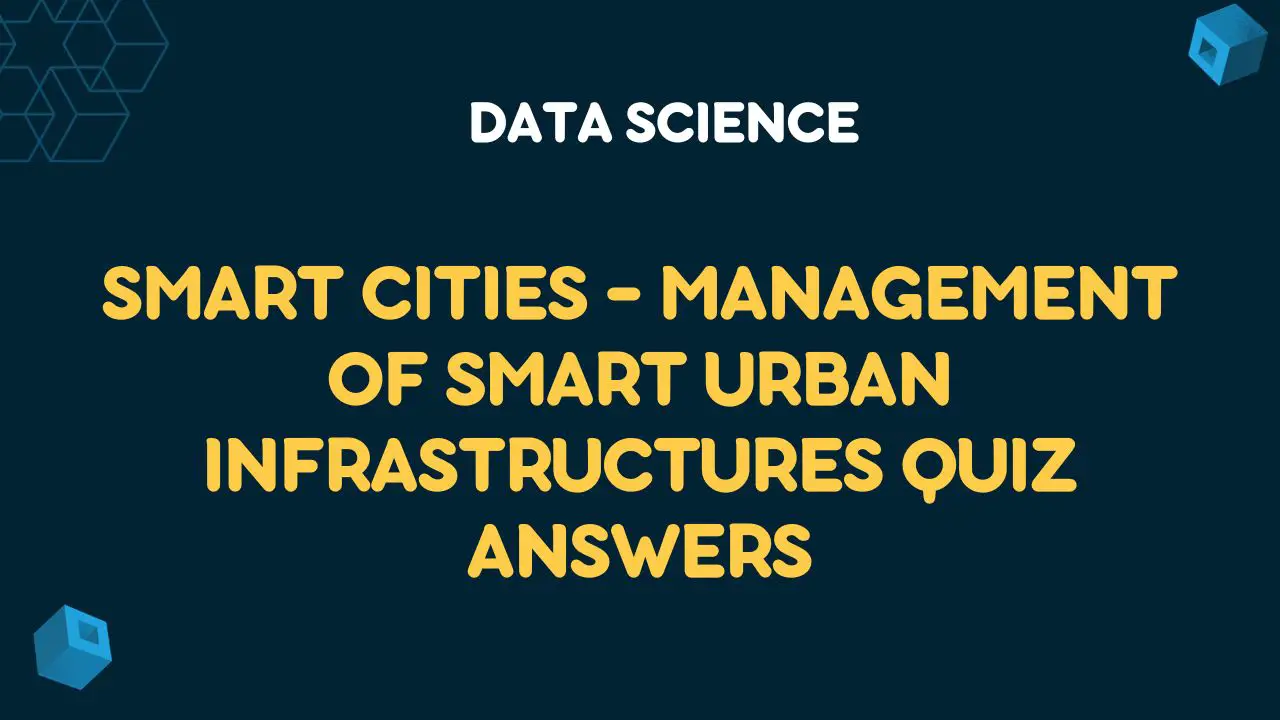Get All Weeks Smart Cities – Management of Smart Urban Infrastructures Quiz Answers
Table of Contents
Smart Cities – Management of Smart Urban Infrastructures Week 01 Coursera Quiz Answers
Quiz 1: What did I learn in Block 1?
Q1. As seen in this MOOC, cities can be studied from different perspectives, and as different types of systems, which can be…
Q2. What are the main layers that are used to conceptualize urban systems in this block?
ViewEconomic layer
Service layer
Q3. What are the three key metrics used in this course to characterize the performance of urban infrastructure systems?
View2.Efficiency
3.Resilience
Q4. As seen in this block, how does the conceptualization of smart cities differ from the traditional conceptualization of urban systems?
ViewQ5. Which of the following components enables the development of the data layer for Smart Cities?
ViewQ6. Which of the following definitions best describes digitalization?
ViewQ7. Which option best describes how digitalization is being used to improve value chains?
ViewQ8. Which of the following options are not examples of digitalization?
ViewWind turbines
Q9. According to this MOOC, what are the two main visions for implementing a smart city?
ViewUsers as citizens: In this view, the public sector leads the transition, and the city is built to serve the citizens.
Q10. A Socio-Technical system can be defined as…
ViewQ11. Which of the following smart city visions relies on a technology-push approach?
ViewQ12. One of the key disruptions caused by digitalization relates to the fact that the value chain information mirrored in the data layer can be used to improve the layer or create new services and business models that allow companies to find new ways to profit. True or false?
ViewQ13. Smart cities can be seen from a…
ViewQ14. According to this MOOC, how does digitalization affect non-scalable industries, such as the taxi industry?
ViewQ15. According to the lectures, which of the following statements is more accurate about the impact of digitalization on the management of cities as socio-technical systems?
ViewQuiz 1: What did I learn in Block 2?
Q1. According to this MOOC, what are the three main drivers of the transition towards smart urban energy systems?
View2.Climate change
3.Digitalization
Q2. What percentage of global primary energy is consumed in cities?
ViewQ3. According to this MOOC, which key elements drive the smart urban energy transition?
ViewEnergy efficiency
Off and semi-off-grid operations
New storage technologies
Q4. According to this MOOC, which of the following actors is not involved in the operation of smart urban energy systems?
ViewQ5. Which option best defines price signals?
ViewQ6. Which of the following actors is the least involved in the management of smart urban energy systems?
ViewQ7. According to this MOOC, who are the main smart energy service customers?
ViewHouseholds
Q8. Which of the following options best describes smart energy balancing?
ViewQ9. According to this MOOC, who are the customers of demand-side management services?
View2.Households
3.Commerce & industry
Q10. What are the main challenges for urban managers in the infrastructure layer?
ViewManaging intermittency and grid stability
Q11. Which of the following is not one of the main smart urban energy system challenges for policymakers in the data layer?
ViewQ12. From a social perspective, what are the main challenges for policymakers
View2.Regulating privacy issues
Q13. Which of the following is a target customer for smart balancing services?
ViewBuildings
Households
Q14. According to this MOOC, what are the three main kinds of smart urban energy services?
View2.Contract enforcement
3.Smart balancing
Q15. Which of the following is not an example of smart and integrated energy services?
ViewQuiz 1: What did I learn in Block 3?
Q1. By the year 2050, what is the rate of urbanization expected to be worldwide?
ViewQ2. Which of the following statements is more accurate?
ViewQ3. What percentage of global CO2 emissions originate from the urban transportation sector?
ViewQ4. Digitalization is leading transportation systems to a change in paradigm characterized by a shift…
ViewQ5. According to this MOOC, what are the two pathways of transition towards smart urban transportation systems?
ViewShift pathway
Q6. According to this MOOC, what are the two main trends under the improved pathway?
ViewThe introduction of self-driving vehicles
The development of Mobility as a Service (MaaS)
Q7. Which option describes Level 2 of vehicle automation, according to the U.S. Department of Transportation?
ViewQ8. What are two new communication processes that need to be developed in order to ensure the successful introduction of automated vehicles?
ViewV2V Communication – Vehicles must be able to communicate with surrounding vehicles.
Q9. According to this MOOC, which of the following are key challenges in the service layer for the successful introduction of automated vehicles?
ViewAccountability: in case of accidents, who will be held responsible?
Q10. Which of the following options are examples of mobility services that rely on sharing economy processes?
ViewCar sharing
Carpooling
Q11. Which of the following statements regarding Mobility-as-a-Service (MaaS) and Integrated Mobility Platforms (IMP) is correct?
ViewQ12. As seen in this block, which of the following is not an example of an emerging business model in the mobility sector?
ViewQ13. According to this MOOC, which of the following are smart urban mobility challenges in the infrastructure layer for policymakers?
ViewInterconnecting transport modes
Q14. According to this MOOC, in the Smart Mobility domain, which of the following are challenges for policymakers from a political perspective?
ViewData regulation
Q15. According to this MOOC, in the Smart Mobility domain, which of the following are challenges for urban managers from a technological perspective?
ViewInterconnection of modes
Quiz 1: What did I learn in Block 4?
Q1. What are three key factors that exist in most complex systems?
View2.Interdependency
3.Path dependency
Q2. Feedback loops are defined as…
ViewQ3. What should managers and planners avoid to ensure a successful transition towards smart cities?
ViewQ4. Which of these approaches is necessary to successfully transition towards smart cities, given the complex nature of cities as socio-technical systems?
View2.Holistic approach
3.Flexibility
Q5. Which of the following factors can be seen as a key driver of the dynamicity of a system?
ViewQ6. Which of the following options best describes the S curve?
ViewQ7. What are the main issues faced when adopting a crowd-sensing approach to data collection?
ViewQ8. According to this MOOC, which of the following questions pertaining the data layer transition must be addressed by industry stakeholders?
View2.Which data standards will be used?
3.Who will own the data?
Q9. According to this MOOC, which of the following questions pertaining the data layer transition must be addressed by city authorities?
View2.Who will own the data?
3.Where will the data be located?
Q10. What is the right sequencing of questions regarding the definition and development of the data layer, based on the lectures in this block?
ViewData standards
Data pricing
Q11. According to this MOOC, what is the main requirement to ensure proper identification and access in the data layer?
ViewQ12. According to this MOOC, what are some examples of stakeholders who could already own the data generated in smart cities?
View2.Telecommunications operators
Q13. When referring to the necessity of a holistic approach in managing the transition in socio-technical systems, which of the below dimensions is of most importance?
ViewQ14. Why is there a clash between traditional infrastructure regulation and in-development data regulation?
ViewQ15. What is the primary advantage of AI (Artificial Intelligence) for the management of urban systems?
ViewQuiz 1: What did I learn in Block 5?
Q1. According to this MOOC, what are the three main challenges in the service layer to transition towards smart cities?
View2.Service Integration
3.Universal services obligation
Q2. What are the indicators by which the Universal Services Obligations are measured?
View2.Quality
3.Affordability
Q3. What are the three questions raised in relation to the affordability of Universal Services Obligations?
ViewThe use of subsidies
Q4. Among the providers for these basic services, competition exists; however, there is a trend towards the concentration of the market shares. This leads the way to monopolies, which could significantly improve service quality. True or false?
ViewQ5. Which of the following statements is incorrect?
ViewQ6. According to this MOOC, what are the two main alternatives for political priorities when planning a transition towards a smart city?
View2.Smart city promotion
Q7. Which of the following statements best describes the digital divide?
ViewQ8. According to this MOOC, what is the key risk of setting smart city infrastructure development as a political priority?
ViewQ9. How can we ensure that the smart city service providers are not cream-skimming the infrastructure?
ViewQ10. According to this MOOC, from an environmental perspective, what are the transition challenges for urban managers?
ViewQ11. What are the three steps to roll-out the use of big data analytics in cities?
View2.Develop an IT road-map
3.Define a smart city strategy from a business point of view
Q12. How are big data analytics differentiated from traditional data analytics?
View.
Q13. What percentage of the data gathered is not directly exploitable (considered “dark data”)?
ViewQ14. Which of the following technologies can be used to analyze “dark data”?
View2. Advanced analytics
3.Cognitive computing
4.Machine learning
Q15. Which technological development can be considered as an efficient way to gather data from different channels?
ViewQuiz 2: Final Exam
Q1. What are the key trends that have encouraged a shift towards decentralized electricity generation?
View2.The improvement of storage technologies
Q2. From an economic perspective, what are the main challenges in smart urban energy systems for urban managers?
ViewAllocating the costs of a smart urban energy system
Determining the pricing of the data
Q3. According to this MOOC, which of the following are smart urban mobility challenges in the service layer for urban managers?
ViewBusiness model development
Addressing the digital divide
Q4. In the context of automated vehicles, which of the following scenarios is the most likely to occur in urban transportation systems?
View2.Public transportation will undoubtedly remain the backbone of urban transportation systems, and the last and first miles might be operated by automated vehicles.
Q5. According to this MOOC, why is it important to have flexibility when transitioning into a smart city?
ViewQ6. According to this MOOC, what are the requirements for properly interconnecting the telecommunications infrastructures through the communications network?
ViewStandards
Q7. According to this MOOC, what are the five dimensions that must be considered when transitioning to smart cities?
ViewLegal/Political
Technological
Environmental
Economic
Q8. According to this MOOC, what are the main infrastructure challenges in the smart city transition?
ViewPolitical priorities
Financing
Q9. According to this MOOC, which of the following options best describes the main consequence of digitalization?
ViewQ10. According to this MOOC, which of the following are examples of demand-side management?
ViewGiving financial incentives to reduce consumption during peak hours
Q11. According to this MOOC, what are some characteristics of the shift in the habits of city dwellers?
View2.Desire to concentrate all services and remove the burden of choice
Q12. Fill in the blanks:
Cities are composed of interdependent sub-systems, in which the changes in one subsystem may affect the performance of others. As such, the combination of the (1) of all subsystems results in the performance of the city. Additionally, these systems present high (2): every change or decision made in a socio-technical system is dependent on changes and decisions that were made in the past. Lastly, there is an element of (3) to these systems; the impacts of decisions made and changes introduced in the past are (4) and cannot be undone.
View(3) irreversibility
(4) long-lasting
Q13. According to this MOOC, which of the following are examples of additional urban subsystems in which a smart city transition could also be implemented?
ViewWater and waste
Green infrastructures
Housing
Q14. What are examples of technologies used to analyze “Big Data”?
View2.Machine learning
Q15. Which of the following are examples of data-generating devices?
ViewSmartphones
GPS
Sensors
Q16. According to this MOOC, what is the main trend enabling the transition towards a smart city?
ViewQ17. According to this MOOC, which industries are most affected by digitalization?
ViewQ18. Which of the following is not a prerequisite for the development and transition towards smart cities?
View2.Management and governance of the data layer
Q19. Which of the following best defines a prosumer?
ViewQ20. What are the three kinds of data that can be generated by smart energy systems?
ViewUser behavior
Generator data
Q21. According to this MOOC, which two options best describe the different views of the smart energy data layer?
ViewQ22. What are the three drivers of the transition towards smart mobility systems?
ViewClimate change
Digitalization
Q23. Under the improved pathway, what is the main challenge for the infrastructure layer?
ViewQ24. According to this MOOC, what are examples of transportation schemes that enable the shift pathway?
ViewMobility-as-a-Service (MaaS)
Integrated mobility platforms
Q25. Which of the following statements is more accurate?
ViewQ26. According to this MOOC, which of the following elements of the ‘smart city’ notion is most likely to be addressed on a national or supranational level?
ViewQ27. According to this MOOC, what are the three main aspects of service integration?
View2.Coordinating services across systems
Q28. What is the main accessibility challenge for smart city services?
ViewQ29. What are social tariffs?
ViewQ30. According to this MOOC, if cities choose to finance new smart city infrastructure through the private sector, what must they do?
ViewSmart Cities – Management of Smart Urban Infrastructures Course Review
In our experience, we suggest you enroll in Smart Cities – Management of Smart Urban Infrastructures courses and gain some new skills from Professionals completely free and we assure you will be worth it.
Smart Cities – Management of Smart Urban Infrastructures for free, if you are stuck anywhere between a quiz or a graded assessment quiz, just visit Networking Funda to get Smart Cities – Management of Smart Urban Infrastructures Quiz Answers.
Get All Course Quiz Answers for the Business English Specialization
Business English: Management and Leadership Quiz Answers
Business English: Finance and Economics Quiz Answers
Business English: Marketing and Sales Quiz Answers




